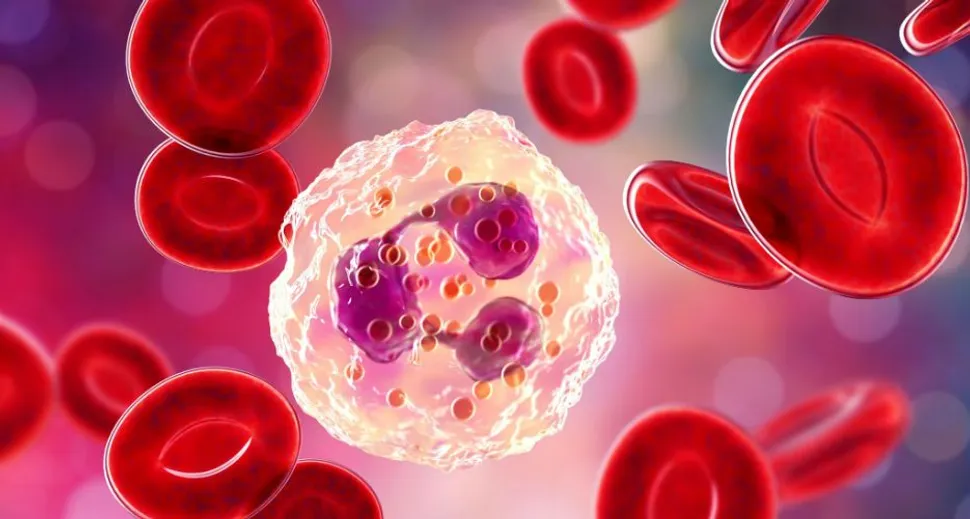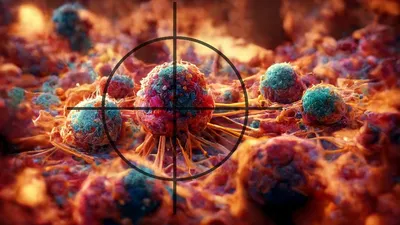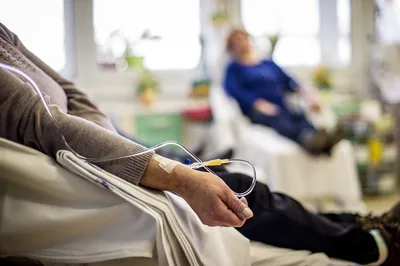What Are Neutrophils in Multiple Myeloma?

What Are Neutrophils?
What are neutrophils, and why do they matter if you have multiple myeloma?
Neutrophils are the most common type of white blood cells (50-70%) and are the first line of defense against injury or infections. Neutrophils block, disable, or digest invading particles and microorganisms. They constantly survey the body for signs of infection and quickly trap and kill pathogens. They also talk to other cells to signal the body to mount an immune response or to help heal damaged cells.
Neutrophils are produced in the bone marrow, and when infection, injury, or inflammation occurs, chemicals alert mature neutrophils to leave the bone marrow and target the site in need. Neutrophils are important in multiple myeloma patients because they can prevent infections, a leading cause of death in multiple myeloma patients.
What Is a Normal Neutrophil Count?
The lab that shows your neutrophil count is called an Absolute Neutrophil Count (ANC). Healthy people have an ANC between 2,500-6,000. Falling below 1,000 makes patients more prone to infections.
What Is Neutrophilia?
Neutrophilia is when the body produces too many neutrophils. This causes a high white blood cell count (this is called leukocytosis). Symptoms often include a fever and frequent infections. You may also have fatigue, dizziness, sores that don't heal, or swollen and painful joints. Neutrophilia is not a condition that can be treated. It is your body's reaction to infection, inflammation, or myeloma (you can also be born with neutrophilia).
High neutrophils can be caused by infection (commonly bacterial), non-infectious inflammation, injuries, emotional stress, obesity, surgery, smoking or sniffing tobacco, excessive exercise, steroid use, heart attacks, genetic conditions like Downs syndrome, surgical removal of the spleen, inflammatory conditions (rheumatoid arthritis, inflammatory bowel disease, hepatitis, vasculitis) or chronic myeloid leukemia.
What Is Neutropenia?
Low neutrophils can be caused by chemotherapy or other cancer treatments, radiation, stem cell transplant, a suppressed immune system, bone marrow failure, anemia, febrile neutropenia (a medical emergency), genetic disorders (like Kostmann syndrome and cyclic neutropenia), hepatitis (A, B or C), HIV/AIDS, sepsis, an enlarged spleen, autoimmune diseases (like rheumatoid arthritis), B-12 deficiency, leukemia, or myeloma dysplastic syndromes (MDS).
Some multiple myeloma therapies can cause low neutrophil counts. Patients with low neutrophil counts can be called "neutropenic", and this condition commonly occurs after stem cell transplant or other immunotherapies like CAR T or bispecific antibodies. It can also be caused by three-drug combination therapies, like lenalidomide plus chemotherapy agents or doxorubicin.
Being neutropenic can cause increases in infection, a known, major cause of death in multiple myeloma patients and other patients with cancer.
What Treatment Exists for High or Low Neutrophils?
Treatment for High Neutrophils
Having high neutrophils isn't something that can be treated. It’s a sign of underlying conditions, such as infection and inflammation. You can decrease your risk of having a high neutrophil count (called neutrophilia) by stopping smoking, losing weight, finding ways to manage stress, and protecting yourself against seasonal infections like the flu.
Treatment for Low Neutrophils
If you have just received a stem cell transplant or other myeloma immunotherapy like CAR T, your neutrophil count may recover on its own over time.
In multiple myeloma, Granulocyte-colony stimulating factor (G-CSF) can be used to manage chemotherapy-related neutropenia so that patients may stay on treatment for a longer time and benefit from it. Primary G-CSF can be used proactively when high-risk myeloma regimens are administered or when low/intermediate-risk regimens are used and additional risk factors are present.
If a myeloma patient is experiencing Grade 3 or 4 neutropenia, G-CFS treatment can be given. If neutropenia is persistent, treatment can be delayed until the ANC reaches over 1000 cells/mL. Dose reductions may be necessary.
What Is the Neutropenic Diet?
Neutropenia commonly occurs around 4-5 days after a stem cell transplant, as the melphalan administered kills neutrophils and the cells that produce them in the bone marrow. This is when myeloma patients are extremely prone to infections. If you get an infection while neutropenic, immediate treatment is needed.
During this time of high infection risk due to neutropenia, your doctor might ask you to follow a neutropenic diet. This means limiting the number of foods that could increase the risk of infection or disease when eating them.
Lately, a lot of research has been done in this field. What was thought to be a very strict diet now only needs to be a smart diet, where fruits and vegetables are thoroughly washed, and obvious foods with intentional mold, like blue cheese, are avoided.
Some stem cell transplant centers continue educate their patients to maintain a strict diet. Please research the subject yourself and practice safe eating and hygiene habits after your stem cell transplant to reduce ther risk of infection during this vulnerable time.
People who are educated about their care live longer, better lives. At HealthTree Foundation, we are committed to providing the most accurate and up-to-date information about blood cancer. Subscribe to our newsletter and join the HealthTree community!
Sources:
What Are Neutrophils?
What are neutrophils, and why do they matter if you have multiple myeloma?
Neutrophils are the most common type of white blood cells (50-70%) and are the first line of defense against injury or infections. Neutrophils block, disable, or digest invading particles and microorganisms. They constantly survey the body for signs of infection and quickly trap and kill pathogens. They also talk to other cells to signal the body to mount an immune response or to help heal damaged cells.
Neutrophils are produced in the bone marrow, and when infection, injury, or inflammation occurs, chemicals alert mature neutrophils to leave the bone marrow and target the site in need. Neutrophils are important in multiple myeloma patients because they can prevent infections, a leading cause of death in multiple myeloma patients.
What Is a Normal Neutrophil Count?
The lab that shows your neutrophil count is called an Absolute Neutrophil Count (ANC). Healthy people have an ANC between 2,500-6,000. Falling below 1,000 makes patients more prone to infections.
What Is Neutrophilia?
Neutrophilia is when the body produces too many neutrophils. This causes a high white blood cell count (this is called leukocytosis). Symptoms often include a fever and frequent infections. You may also have fatigue, dizziness, sores that don't heal, or swollen and painful joints. Neutrophilia is not a condition that can be treated. It is your body's reaction to infection, inflammation, or myeloma (you can also be born with neutrophilia).
High neutrophils can be caused by infection (commonly bacterial), non-infectious inflammation, injuries, emotional stress, obesity, surgery, smoking or sniffing tobacco, excessive exercise, steroid use, heart attacks, genetic conditions like Downs syndrome, surgical removal of the spleen, inflammatory conditions (rheumatoid arthritis, inflammatory bowel disease, hepatitis, vasculitis) or chronic myeloid leukemia.
What Is Neutropenia?
Low neutrophils can be caused by chemotherapy or other cancer treatments, radiation, stem cell transplant, a suppressed immune system, bone marrow failure, anemia, febrile neutropenia (a medical emergency), genetic disorders (like Kostmann syndrome and cyclic neutropenia), hepatitis (A, B or C), HIV/AIDS, sepsis, an enlarged spleen, autoimmune diseases (like rheumatoid arthritis), B-12 deficiency, leukemia, or myeloma dysplastic syndromes (MDS).
Some multiple myeloma therapies can cause low neutrophil counts. Patients with low neutrophil counts can be called "neutropenic", and this condition commonly occurs after stem cell transplant or other immunotherapies like CAR T or bispecific antibodies. It can also be caused by three-drug combination therapies, like lenalidomide plus chemotherapy agents or doxorubicin.
Being neutropenic can cause increases in infection, a known, major cause of death in multiple myeloma patients and other patients with cancer.
What Treatment Exists for High or Low Neutrophils?
Treatment for High Neutrophils
Having high neutrophils isn't something that can be treated. It’s a sign of underlying conditions, such as infection and inflammation. You can decrease your risk of having a high neutrophil count (called neutrophilia) by stopping smoking, losing weight, finding ways to manage stress, and protecting yourself against seasonal infections like the flu.
Treatment for Low Neutrophils
If you have just received a stem cell transplant or other myeloma immunotherapy like CAR T, your neutrophil count may recover on its own over time.
In multiple myeloma, Granulocyte-colony stimulating factor (G-CSF) can be used to manage chemotherapy-related neutropenia so that patients may stay on treatment for a longer time and benefit from it. Primary G-CSF can be used proactively when high-risk myeloma regimens are administered or when low/intermediate-risk regimens are used and additional risk factors are present.
If a myeloma patient is experiencing Grade 3 or 4 neutropenia, G-CFS treatment can be given. If neutropenia is persistent, treatment can be delayed until the ANC reaches over 1000 cells/mL. Dose reductions may be necessary.
What Is the Neutropenic Diet?
Neutropenia commonly occurs around 4-5 days after a stem cell transplant, as the melphalan administered kills neutrophils and the cells that produce them in the bone marrow. This is when myeloma patients are extremely prone to infections. If you get an infection while neutropenic, immediate treatment is needed.
During this time of high infection risk due to neutropenia, your doctor might ask you to follow a neutropenic diet. This means limiting the number of foods that could increase the risk of infection or disease when eating them.
Lately, a lot of research has been done in this field. What was thought to be a very strict diet now only needs to be a smart diet, where fruits and vegetables are thoroughly washed, and obvious foods with intentional mold, like blue cheese, are avoided.
Some stem cell transplant centers continue educate their patients to maintain a strict diet. Please research the subject yourself and practice safe eating and hygiene habits after your stem cell transplant to reduce ther risk of infection during this vulnerable time.
People who are educated about their care live longer, better lives. At HealthTree Foundation, we are committed to providing the most accurate and up-to-date information about blood cancer. Subscribe to our newsletter and join the HealthTree community!
Sources:
about the author
Jennifer Ahlstrom
Myeloma survivor, patient advocate, wife, mom of 6. Believer that patients can contribute to cures by joining HealthTree Cure Hub and joining clinical research. Founder and CEO of HealthTree Foundation.
More on Core Education
Get the latest thought leadership on your Lymphoma delivered straight to your inbox
Subscribe to the weekly newsletter for news, stories, clinical trial updates, and helpful resources and events with cancer experts.
Thanks to our HealthTree Community for Lymphoma Sponsors:
.svg_64899492-87cd-4df9-9d4b-07f9618df890.png?alt=media)












